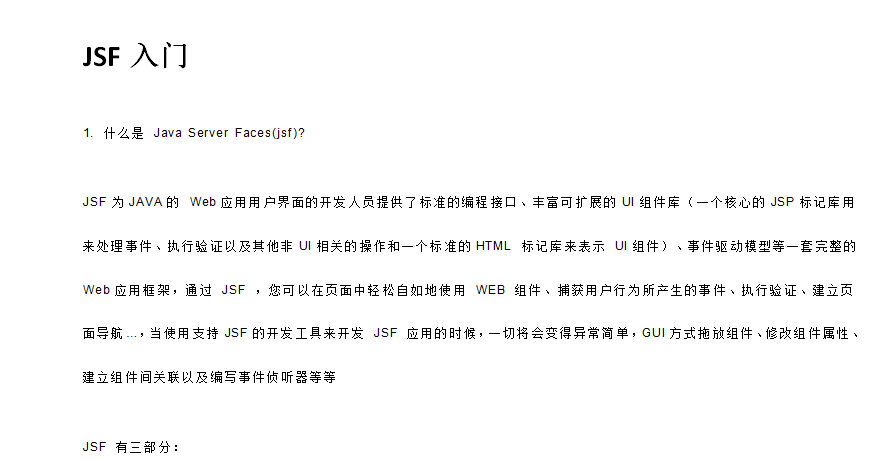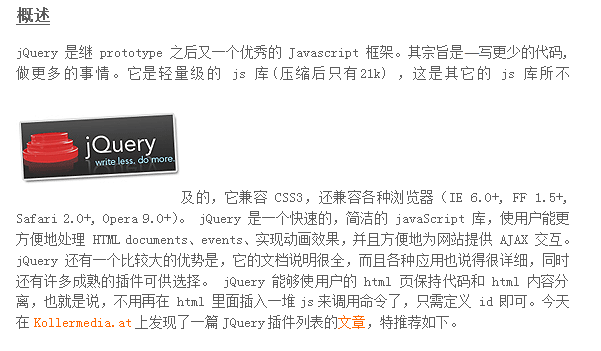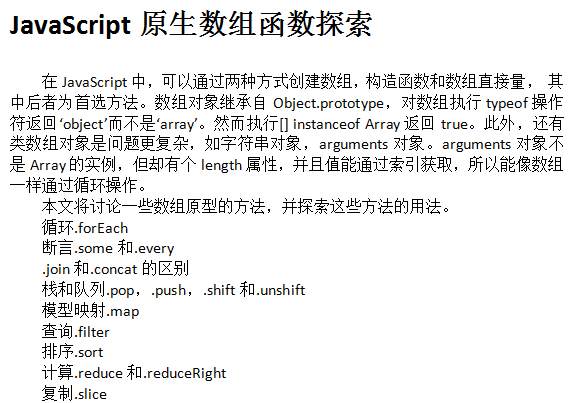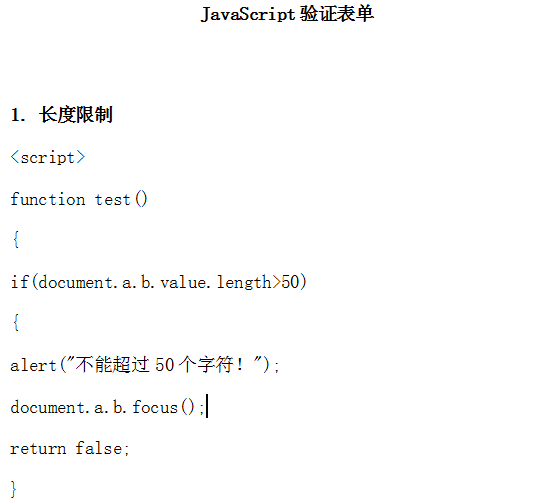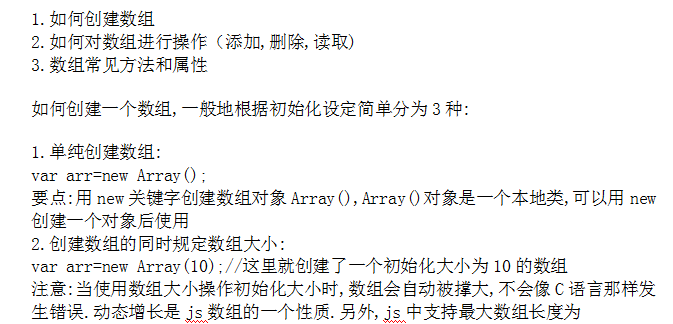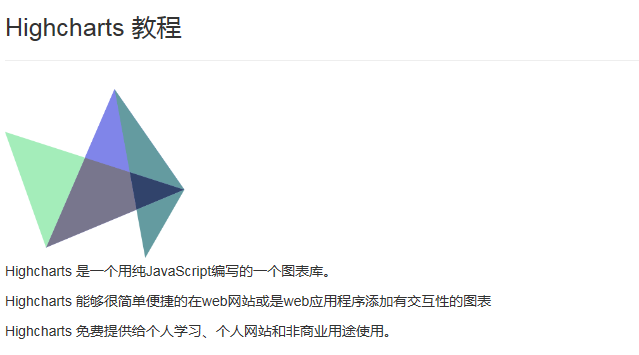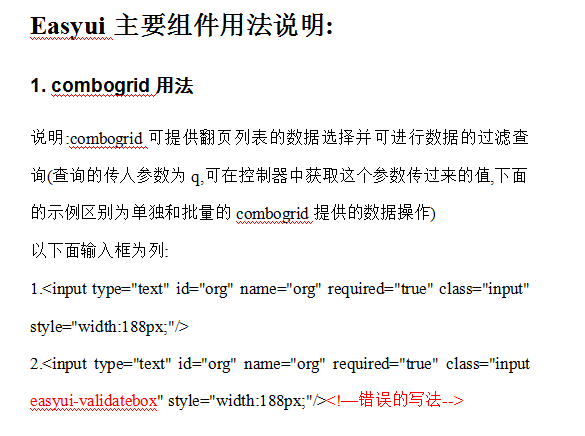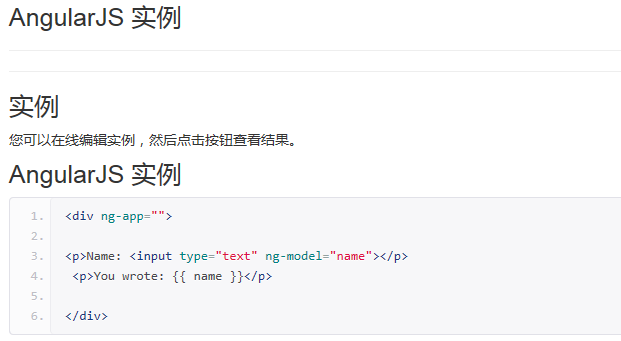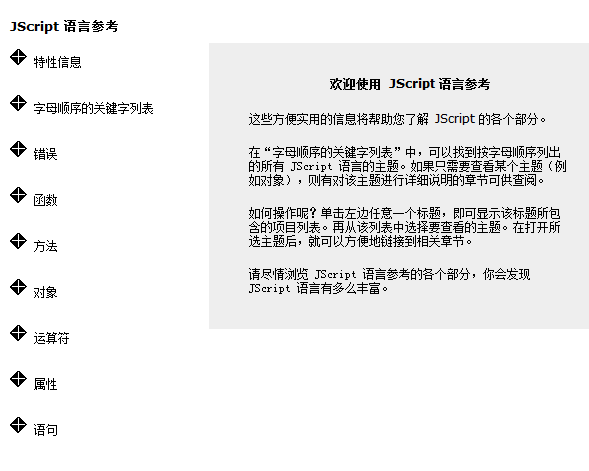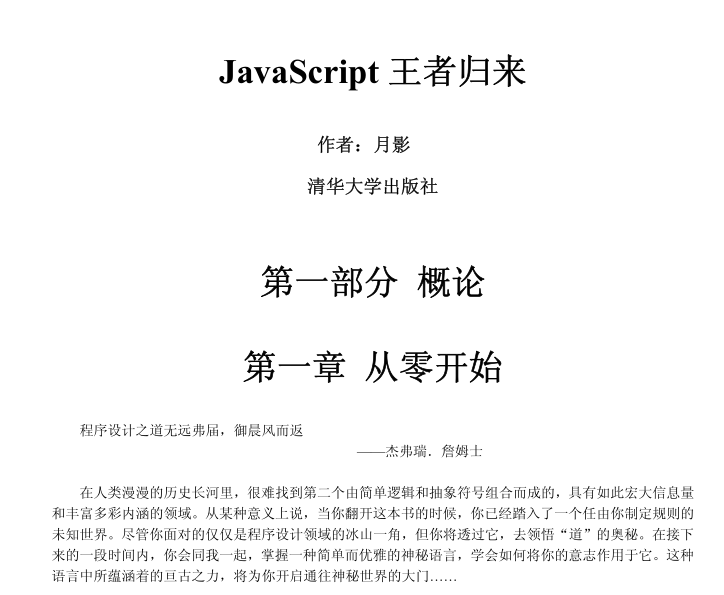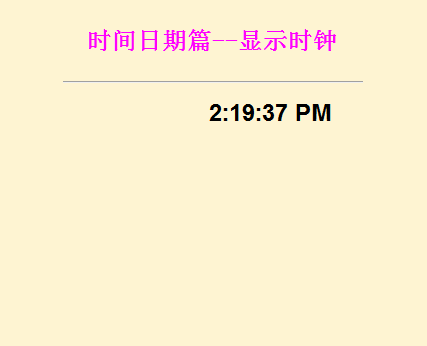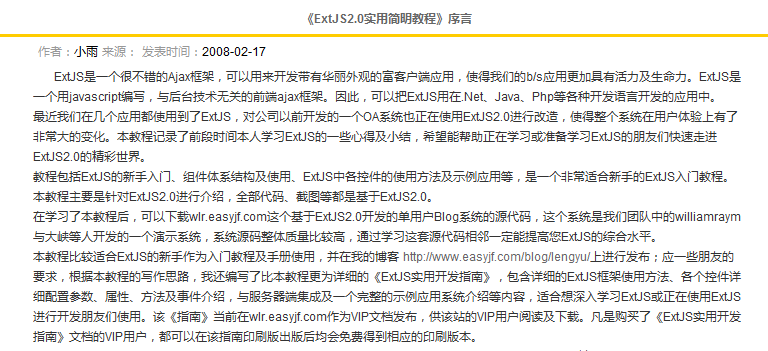Home > Download > Learning resources > Web page production

This document mainly describes the in-depth study of JSF; JSF provides standard programming interfaces and a rich and extensible UI component library for developers of JAVA web application user interfaces (a core JSP tag library is used to process events and perform verification As well as other non-UI related operations and a standard HTML tag library to represent UI components), event-driven model and other complete set of Web application framework, through JSF, you can easily use WEB components in the page, capture user behavior Generated events, perform validation, establish page navigation... When using development tools that support JSF to develop JSF applications, everything will become extremely simple. GUI mode drag and drop components, modify component properties, establish relationships between components, and Write event listeners and more. I hope this document will help friends in need; interested friends can come and take a look.
Web page production29587202018-01-18
<p> This document mainly talks about jquery plug-in special effects; jQuery is another excellent Javascript framework after prototype. Its purpose is to write less code and do more. </p> <p> jQuery is a fast, concise javaScript library that allows users to more easily process HTML documents and events, implement animation effects, and easily provide AJAX interactions for websites. Another big advantage of jQuery is that its documentation is very complete and its various applications are explained in detail. There are also many mature plug-ins to choose from. I hope this document will help friends in need; interested friends can come and take a look. </p>
Web page production29586962018-01-18
This document mainly talks about the jQuery Flash effect plug-in; jQuery is a fast and easy-to-use JavaScript framework that can achieve various Ajax, animation, and filter effects with just a few lines of code. I hope this document will help friends in need; interested friends can come and take a look.
Web page production29592552018-01-18
This document mainly talks about the exploration of JavaScript native array functions; in JavaScript, arrays can be created in two ways, constructors and array literals, with the latter being the preferred method. I hope this document will help friends in need; interested friends can come and take a look.
Web page production29588722018-01-18
<p class="MsoNormal" align="center" style="text-align:center;"> <b>JavaScript Validation Form</b><b></b> </p> <p class="MsoNormal"> <b> </b> </p> <p class="MsoNormal"> <b>1. Length limit</b><b><br /> </b><script><br /> function test() <br /> {<br /> if(document.a.b.value.length>50)<br /> {<br /> alert("Cannot exceed 50 characters!");<br /> document.a.b.focus();<br /> return false;<br /> }<br /> }<br /> </script> </p>
Web page production29587842018-01-18
This document mainly talks about Javascript arrays and their operations; I hope this document will help friends in need; interested friends can come and take a look.
Web page production29589102018-01-18
This document mainly talks about JavaScript's RegExp object; JavaScript's RegExp object and String object define methods for using regular expressions to perform powerful pattern matching and text retrieval and replacement functions. I hope this document will help friends in need; interested friends can come and take a look.
Web page production29587442018-01-18
<p> <strong>Highcharts </strong> is a chart library written in pure JavaScript. Highcharts makes it easy and convenient to add interactive charts to web sites or web applications. This article brings you the Highcharts reference manual. You can download it if you need it. </p> <p> Highcharts is free for personal study, personal website, and non-commercial use. </p> <p> <strong>HighCharts Features<br /> </strong>Compatibility - Supports all major browsers and mobile platforms (android, iOS, etc.). <br /> Multi-device - supports multiple devices, such as handheld devices iPhone/iPad, tablets, etc. <br /> Free to use - Open source and free. <br /> Lightweight - highcharts.js core library size is only about 35KB. <br /> Simple configuration - use json format configuration<br /> Dynamic - Can be modified after the chart is generated. <br /> Multidimensional - Supports multidimensional charts<br /> Configure prompt tool - when the mouse is moved to a certain point on the chart, prompt information will appear. <br /> Timeline - can be accurate to milliseconds. <br /> Export - Tables can be exported to PDF/ PNG/ JPG / SVG format<br /> Output - Web page output chart. <br /> Zoomable - Select the chart part to enlarge and observe the chart closely;<br /> External data - Load dynamic data from the server. <br /> Text Rotation - Supports label rotation in any direction. </p>
Web page production29595032018-01-18
This document mainly talks about the usage of Easyui components; I hope this document will help friends in need; interested friends can come and take a look.
Web page production29587832018-01-18
This document mainly describes the features of the AngularJS front-end framework; AngularJS (Angular.JS) is a set of frameworks, templates, data binding and rich UI components used to develop web pages. It supports the entire development process and provides the architecture of web applications without manual DOM manipulation. AngularJS is small, only 60K, compatible with mainstream browsers, and works well with jQuery. I hope this document will help friends in need; interested friends can come and take a look.
Web page production29594902018-01-18
<p> <strong>AngularJS</strong> is a JavaScript framework. It can be added to HTML pages via the <script> tag. This article mainly brings you the AngularJS reference manual. Friends who need it can download it and take a look! </p> <p> AngularJS extends HTML through directives and binds data to HTML through expressions. </p> <p> AngularJS is a JavaScript framework<br /> AngularJS is a JavaScript framework. It is a library written in JavaScript. </p> <p> AngularJS is published as a JavaScript file, which can be added to web pages through the script tag: </p>
Web page production29588812018-01-18
Many users are looking for the Chinese manual of JavaScript, because there are very few Chinese manuals of JavaScript. Generally, it is the official manual of Microsoft. What I bring to you this time is Microsoft’s official "JavaScript Language Reference"<br /> 1. w3cschool JavaScript tutorial<br /> 2. JavaScript parameters released by css8<br /> 3. javascript-cheat-sheet<br /> 4. Microsoft Jscript Manual
Web page production29637852018-01-17
Software technical documentation, WEB application development. This article is not a JavaScript-focused read. It's just a quick guide for beginners. <br /> main content: <br /> ◆ Briefly introduce the JavaScript language and the objects processed by JavaScript—properties and methods; <br /> ◆ Method to add JavaScript code to HTML document; <br /> ◆An example of the most commonly used scenario in JavaScript - validating user input; <br /> ◆ JavaScript document object model diagram; <br /> ◆ JavaScript string objects and date objects; <br /> ◆ Window objects and frame windows (FrameSet, IFrame); <br /> ◆ Regular expression pattern matching - verify user input; <br /> ◆ Reference JavaScript code: preload images to achieve dynamic changes in navigation buttons; <br /> ◆ Reference JavaScript code: display the prompt information of the object; <br /> ◆ Reference JavaScript code: exquisite calendar; <br /> ◆ Reference JavaScript code: drop-down menu; <br /> ◆ Reference JavaScript code: similar to the tree map of the resource manager; <br /> ◆Referenceable JavaScript code: a WYSIWYG editor;
Web page production29640162018-01-17
Since jQuery 1.3 was released on January 14, 2008, it has attracted attention from all walks of life. We immediately started working on translating the documents. After 4 days of hard work, it was finally completed. Due to the Chinese New Year, I was unable to make the CHM version in time. I specially compiled it on the day when the work started. Due to the tight schedule, there will inevitably be errors. If you find any errors, please contact me and I will promptly Correction. <br /> Since jQuery came out, it has impressed the hearts of everyone who pays attention to it with its speed, simplicity, ability to easily process HTML documents, control events, add animation and Ajax effects to pages, and I am no exception. But for a long time, Similar to this manual (with query function), it is only made by kuomart (I don’t know the specific name here, I just found this name from the manual I own, so I will call it this for now, if you know it, please let me know!), but in the long run There is no update, which brings inconvenience to everyone learning jQuery. For my own convenience and for the convenience of all jQuery-loving friends, I have reorganized CHM and updated this CHM manual synchronously with Shawphy, the organizer of jQuery Chinese API, so that everyone can keep up to date with its latest information! Due to my limited energy, errors will inevitably occur, please understand and inform me via email!
Web page production29639662018-01-17
Object-oriented programming (OOP) is a programming paradigm and a method of program development. Object refers to an instance of a class. It takes objects as the basic unit of programs and encapsulates programs and data to improve software reusability, flexibility and scalability.
Web page production29641182018-01-17
This book is a general JavaScript specification tutorial, suitable for developers at different levels such as advanced, intermediate, and beginners. This book will introduce us to JavaScript and JScript related knowledge, including basic concepts, objects, functions, etc. Also serves as a reference book.
Web page production29641502018-01-17
Contains functions Object Prototype inherits the browser environment. The content of the book is also packaged and compiled by the author. I hope it will be helpful for learning javascript.
Web page production29637502018-01-17
<p> <span>Table of contents </span> </p><p> Part One Introduction<br /> Chapter 1 Starting from Scratch<br /> 1.1 Why choose JavaScript? <br /> 1.1.1 User preference--B/S mode <br /> 1.1.2 When to use JavaScript <br /> 1.1.3 Some misunderstandings about JavaScript <br /> 1.1.3.1 The relationship between JavaScript and Java <br /> 1.1.3.2 Lisp in C clothing <br /> 1.1.3.3 Thinking about JavaScript <br /> 1.1.3.4 Is JavaScript designed for amateurs? <br /> 1.1.3.5 Is JavaScript object-oriented <br /> 1.1.3.6 Other misunderstandings <br /> 1.1.4 Be alert! Script Temptation <br /> 1.1.5 Complexity hidden under simple appearance <br /> 1.1.6 The confusing choice-the icing on the cake or the timely help Part One Introduction<br /> Chapter 1 Starting from Scratch<br /> 1.1 Why choose JavaScript? <br /> 1.1.1 User preference--B/S mode <br /> 1.1.2 When to use JavaScript <br /> 1.1.3 Some misunderstandings about JavaScript <br /> 1.1.3.1 The relationship between JavaScript and Java <br /> 1.1.3.2 Lisp in C clothing <br /> 1.1.3.3 Thinking about JavaScript <br /> 1.1.3.4 Is JavaScript designed for amateurs? <br /> 1.1.3.5 Is JavaScript object-oriented <br /> 1.1.3.6 Other misunderstandings <br /> 1.1.4 Be alert! Script Temptation <br /> 1.1.5 Complexity hidden under simple appearance <br /> 1.1.6 Confusing choice--the icing on the cake or the timely help <br /> 1.1.7 Back to the question <br /> 1.2 Application scope of JavaScript <br /> 1.2.1 Client-side JavaScript <br /> 1.2.2 Server-side JavaScript <br /> 1.2.3 JavaScript in other environments <br /> 1.3 JavaScript version <br /> 1.3.1 JavaScript version in the browser <br /> 1.3.2 Other versions <br /> 1.4 Some features worth noting <br /> 1.4.1 Little trick--magical magic code <br /> 1.4.2 Serving clients--classic Hello World! Another JavaScript implementation <br /> 1.4.3 Data interaction--a powerful function of JavaScript <br /> 1.4.4 JavaScript’s apparent taboos and how to break through them <br /> 1.5 Security and execution efficiency <br /> 1.5.1 Data security--forever a sensitive topic <br /> 1.5.2 Actual combat! Attack and Defense <br /> 1.5.3 No carelessness - always pay attention to performance <br /> 1.6 An example--calculator written in JavaScript <br /> 1.6.1 Start with requirements analysis--What is a calculator? <br /> 1.6.2 System design--how to implement a calculator? <br /> 1.6.3 System implementation--the final implementation of the calculator <br /> 1.6.4 Continuous improvement--iterative software development process <br /> 1.7 Some suggestions for learning and using JavaScript <br /> 1.7.1 Think like a programmer--the four realms of programmers <br /> 1.7.2 Cherish your code <br /> 1.7.3 Learn to debug in the environment <br /> 1.7.4 Be wary of small flaws <br /> 1.7.5 Think before practice - don’t write code easily <br /> 1.7.6 Always look back - even sages cannot completely predict the future <br /> 1.8 About the rest of the book <br /> Chapter 2 JavaScript in the Browser<br /> 2.1 Executable content embedded in web pages <br /> 2.1.1 Where to load JavaScript code <br /> 2.1.2 About the Script tag of the code <br /> 2.1.3 When will my code be executed - JavaScript code in different execution periods <br />2.1.4 Borrowingism--Introducing external JavaScript files <br /> 2.2 Pleasing special effects <br /> 2.2.1 Life lies in movement--The effect of DHTML <br /> 2.2.2 Change your style - the power of CSS <br /> 2.2.3 Using JavaScript to manipulate DOM--an example of a draggable window <br /> 2.3 Use JavaScript to interact with users <br /> 2.3.1 Create a pop-up help and progress bar <br /> 2.3.2 Wrong entry <br /> 2.4 Avoiding script traps <br /> 2.4.1 Reality is not always perfect <br /> 2.4.2 Don’t completely believe what you see <br /> 2.5 Summary <br /> Chapter 3 Development Environment and Debugging Methods<br /> 3.1 What can I use to write scripts--a text editor suitable for writing JavaScript <br /> 3.2 Support from browser <br /> 3.2.1 Mainstream browsers <br /> 3.2.2 Non-mainstream browsers <br /> 3.3 Integrated development environment <br /> 3.3.1 What is an integrated development environment <br /> 3.3.2 Do I need an integrated development environment <br /> 3.3.3 Integrated development environment suitable for JavaScript <br /> 3.4 Debugging tools--a powerful tool to improve development efficiency <br /> 3.4.1 What is debugging <br /> 3.4.2 Original debugging method - debugging using output statements, "reflection" mechanism and debugging objects <br /> 3.4.3 Debugging tools suitable for JavaScript <br /> 3.5 Locating code and call stack <br /> 3.5.1 Step by Step--Single step and breakpoint <br /> 3.5.2 Monitor memory <br /> 3.5.3 Trace the source of the problem--view the call stack <br /> 3.5.4 Encountered trouble--Why can’t I trace the code <br /> 3.6 Browser catching exception <br /> 3.6.1 Exception handling mechanism-an example of try/catch/finally pattern <br /> 3.6.2 Types of exceptions <br /> 3.6.3 When should exceptions be "eaten" <br /> 3.7 Summary <br /> Part 2 JavaScript Core<br /> Chapter 4 Language Structure<br /> 4.1 Basic grammar of JavaScript <br /> 4.1.1 Character set <br /> 4.1.2 Case sensitivity <br /> 4.1.3 Delimiter <br /> 4.1.4 Words, sentences and paragraphs <br /> 4.1.5 Semicolon <br /> 4.1.6 Mark <br /> 4.1.7 Comments <br /> 4.1.8 Reserved words <br /> 4.2 Constants and variables <br /> 4.2.1 Constants and variables <br /> 4.2.2 Variable identifier <br /> 4.2.3 Variable type <br /> 4.2.4 Declaration of variables <br /> 4.2.5 Scope of variables <br /> 4.3 Expressions and operators <br /> 4.3.1 Expression <br /> 4.3.2 Operator overview <br /> 4.3.3 Arithmetic operators <br /> 4.3.4 Relational operators <br /> 4.3.5 Logical operators <br /> 4.3.6 Bit operators <br /> 4.3.7 Assignment operator <br /> 4.3.8 Other operators <br /> 4.3.8.1 Conditional operator <br /> 4.3.8.2 Comma operator <br /> 4.3.8.3 Object operators <br /> 4.3.8.4 Type operators <br /> 4.3.8.5 void operator <br /> 4.3.8.6 Function call operator <br /> 4.4 Control statements <br /> 4.4.1 Expression statement <br /> 4.4.2 Statement block <br /> 4.4.3 Conditional statements <br /> 4.4.4 Loop statement <br /> 4.4.5 Jump statement <br /> 4.4.6 Exception handling statements <br /> 4.4.7 Other statements <br /> 4.4.7.1 var statement <br /> 4.4.7.2 function statement <br /> 4.4.7.3 with statement <br /> 4.4.7.4 Empty statement <br /> 4.5 Summary <br /> Chapter 5 Data Type<br /> 5.1 Basic data types <br /> 5.1.1 Value <br />5.1.2 String--an example of string-related operations <br /> 5.1.3 Boolean <br /> 5.2 Arrays and objects <br /> 5.2.1 Array <br /> 5.2.2 Object--an example of a constructor <br /> 5.3 Function type--an example of function and closure <br /> 5.4 Magical null and undefined <br /> 5.4.1 null <br /> 5.4.2 undefined--unique type <br /> 5.5 Regular expression <br /> 5.5.1 Regular expression constants <br /> 5.5.2 Regular expression object <br /> 5.6 Value types and reference types <br /> 5.6.1 What are values and value references <br /> 5.6.2 Using values and using references <br /> 5.6.3 Conversion between values and references: boxing and unboxing <br /> 5.7 Type identification and type conversion <br /> 5.7.1 Runtime type recognition--two examples of running type recognition <br /> 5.7.2 Automatic conversion of types and examples <br /> 5.7.3 Forced type conversion and its examples <br /> 5.7.4 Advanced usage--an example of custom type conversion <br /> 5.8 Beware of numerical traps <br /> 5.8.1 Confusion--precision problem of floating point numbers <br /> 5.8.2 Error correction and examples <br /> 5.9 Summary <br /> Chapter 6 Function<br /> 6.1 Function definition and function call <br /> 6.1.1 Function definition <br /> 6.1.1.1 Declarative function definitions and function expressions and their examples <br /> 6.1.1.2 The secret of JavaScript functions - magic code <br /> 6.1.2 Function call <br /> 6.2 Function parameters <br /> 6.2.1 Formal Participant Actual Parameters <br /> 6.2.2 Arguments object <br /> 6.2.2.1 An example of using Arguments object to detect formal parameters <br /> 6.2.2.2 An example of using the Arguments object to receive any number of parameters <br /> 6.2.2.3 An example of using Arguments object to simulate function overloading <br /> 6.2.3 Parameter type matching--an example of using arguments to implement function overloading mechanism <br /> 6.3 Callers and owners of functions <br /> 6.3.1 Caller of function <br /> 6.3.2 Owner of function--an example of specifying an owner for a function <br /> 6.3.3 Dynamic call--foreign owner <br /> 6.4 Function constants and closures <br /> 6.4.1 Anonymous functions <br /> 6.4.2 Function reference <br /> 6.4.3 Function parameters and function return values and their examples <br /> 6.4.4 Advanced usage--closure as local domain and delayed evaluation <br /> 6.5 Advanced abstraction--Function type and function template <br /> 6.5.1 Dynamically creating functions--an example of using Function to implement Lambda operator <br /> 6.5.2 Pattern--Function factory and its instances <br /> 6.6 Summary <br /> Chapter 7 Object<br /> 7.1 What is an object <br /> 7.2 Object properties and methods <br /> 7.2.1 Built-in properties of objects <br /> 7.2.2 Adding and deleting attributes to objects <br /> 7.2.3 Reflection mechanism--enumeration object properties <br /> 7.3 Object construction <br /> 7.3.1 Constructor--an example of a double-precision floating-point number wrapper class <br /> 7.3.2 Default construction and copy construction <br /> 7.3.3 Object constant <br /> 7.4 Object destruction and storage unit recycling <br /> 7.5 JavaScript’s built-in objects <br /> 7.5.1 Math object <br /> 7.5.2 Date object--create a simple calendar <br /> 7.5.3 Error object <br /> 7.5.4 Other built-in objects <br /> 7.5.5 Special objects--global objects and calling objects <br /> 7.6 Summary <br /> Chapter 8 Collection<br />8.1 Arrays and array elements <br /> 8.1.1 Array construction <br /> 8.1.2 Array constant <br /> 8.1.3 Array elements <br /> 8.2 Array objects and methods <br /> 8.2.1 Find elements <br /> 8.2.2 Adding and deleting elements <br /> 8.2.3 Set operations and examples <br /> 8.2.3.1 join() method <br /> 8.2.3.2 reverse() method <br /> 8.2.3.3 sort() method <br /> 8.2.3.4 concat() method <br /> 8.2.3.5 slice() method <br /> 8.2.3.6 splice() method <br /> 8.2.3.7 toSgring() method and toLocaleString() method <br /> 8.3 Hash table <br /> 8.3.1 What is a hash table <br /> 8.3.2 Construction of hash table <br /> 8.3.3 Implement a simple HashTable type <br /> 8.4 Advanced usage--set operations and closures <br /> 8.5 Summary <br /> Chapter 9 String<br /> 9.1 String construction <br /> 9.1.1 String constant <br /> 9.1.2 Escape sequences <br /> 9.1.3 String constructor <br /> 9.2 Use of strings <br /> 9.2.1 Comparing strings <br /> 9.2.2 Extracting and retrieving substrings <br /> 9.2.3 Concatenate and split strings <br /> 9.2.4 Pattern matching of strings--an example of string format verification <br /> 9.2.5 Other methods <br /> 9.3 Strings and character arrays <br /> 9.4 String and text processing--JavaScript chess record reader (1) <br /> 9.4.1 Requirements Analysis--What are chess records and chess record readers <br /> 9.4.2 System design--String description of chess records and chessboard data <br /> 9.4.3 System implementation--parsing and processing chess records <br /> 9.4.4 Complete chess record reader <br /> 9.5 Summary <br /> Chapter 10 Regular Expressions<br /> 10.1 What is a regular expression <br /> 10.1.1 The concept of regular expression <br /> 10.1.2 Regular expressions in JavaScript <br /> 10.2 Rules of regular expressions <br /> 10.2.1 Literal character <br /> 10.2.2 Character classes and Boolean operations <br /> 10.2.3 Repeat <br /> 10.2.4 Selection, grouping and referencing <br /> 10.2.5 Specify matching position <br /> 10.2.6 Flags—Rules for Advanced Pattern Matching <br /> 10.3 Pattern matching <br /> 10.3.1 String methods and examples for pattern matching <br /> 10.3.2 RegExp method for pattern matching <br /> 10.3.2.1 An example of using the exec() method to obtain the birthday from the ID number <br /> 10.3.2.2 An example of using the test() method to traverse a string <br /> 10.4 About regular expression packaging objects <br /> 10.4.1 RegExp object - using regular expressions to implement full-text retrieval <br /> 10.4.2 Instance properties of RegExp <br /> 10.5 Powerful regular expressions <br /> 10.5.1 Analyzing parts of regular expressions <br /> 10.5.2 An example--powerful online editor <br /> 10.5.3 Constructing a new grammar--an example of implementing the JSVM2 parser in JSVM <br /> 10.6 Advanced usage <br /> 10.7 Processing text with regular expressions <br /> 10.7.1 Create a pricing formula editor <br /> 10.7.1.1 Requirements Analysis--What is the Pricing Formula Editor <br /> 10.7.1.2 System implementation--implementation of pricing formula editor <br /> 10.7.2 Create a synchronous scrolling lyrics player <br /> 10.7.2.1 Requirements Analysis--What is a synchronous scrolling lyrics player <br /> 10.7.2.2 System design and implementation--processing LRC lyrics <br /> 10.8 Summary <br /> Part 3 Browser and DOM<br />Chapter 11 Browser Object<br /> 11.1 Window object--the most basic browser object <br /> 11.1.1 Window object overview <br /> 11.1.2 Life cycle of Window object <br /> 11.1.3 Properties and methods of Window object <br /> 11.1.4 An example of a multi-window application <br /> 11.2 Document object - represents the content of the browser window document <br /> 11.2.1 Document object overview <br /> 11.2.2 Dynamically generated documents <br /> 11.2.3 Basic information of Document object <br /> 11.2.4 Appearance properties of Document object <br /> 11.2.5 Document sub-object interface <br /> 11.2.5.1 An example of traversing Anchors objects <br /> 11.2.5.2 An example of an upside-down image <br /> 11.3 Dialog box and status bar <br /> 11.3.1 Create a simple dialog box <br /> 11.3.2 Other types of dialog boxes <br /> 11.3.2.1 Simulating dialog boxes--examples of creating a window dialog box and a blocked dialog box <br /> 11.3.2.2 showModalDialog and showModelessDialog--not W3C or ECMAScrip standard <br /> 11.3.3 Status bar <br /> 11.4 Framework--upper Window object <br /> 11.4.1 Multi-framework application <br /> 11.4.2 Relationship between frameworks <br /> 11.4.3 Naming of the framework <br /> 11.4.4 JavaScript in subframes <br /> 11.4.5 Application of framework--multi-tab display <br /> 11.4.5.1 What is a tab <br /> 11.4.5.2 Implementation of tabs--Create a page containing tabs <br /> 11.5 Forms and form objects <br /> 11.5.1 Form object and its examples <br /> 11.5.2 Define form elements <br /> 11.5.3 Client form validation and examples <br /> 11.5.4 Create a universal client form validation component <br /> 11.6 Other built-in objects <br /> 11.6.1 Navigator object--representative of overall browser information <br /> 11.6.2 Screen object--provides information about the display resolution and the number of available colors <br /> 11.6.3 Location object - represents the URL of the document displayed in the current window <br /> 11.6.4 History object--an interesting object <br /> 11.7 Summary <br /> Chapter 12 Document Object Model<br /> 12.1 What is DOM <br /> 12.1.1 Representing documents as trees <br /> 12.1.2 Tree nodes <br /> 12.1.3 Common properties and methods of DOM objects <br /> 12.1.4 The relationship between HTML structure and DOM objects--using JavaScript to operate HTML documents through DOM <br /> 12.2 DOM and browser implementation <br /> 12.2.1 About DOM HTML API <br /> 12.2.2 Levels and characteristics of DOM <br /> 12.2.3 DOM consistency <br /> 12.2.4 Differences--Browser DOM dialect <br /> 12.3 A set of "boxes"--DOM elements <br /> 12.3.1 Nested “boxes” <br /> 12.3.2 Classification of “boxes” and “box” contents <br /> 12.4 Create and delete nodes <br /> 12.4.1 Construct a new node <br /> 12.4.2 Flat expansion--directly created through document elements <br /> 12.4.3 Reclaim space--delete unused nodes <br /> 12.5 Access and manipulate DOM nodes <br /> 12.5.1 Open each box--traverse nodes <br /> 12.5.2 Clarify the hierarchical relationship--father, son and brother <br /> 12.5.3 How to search for a specific node <br /> 12.5.4 Clone node--an example of using cloneNode() to copy a table <br /> 12.5.5 Mobile nodes and their examples <br /> 12.5.6 Tips on adding new rows and sorting <br /> 12.6 Reading and writing data--adding, modifying and deleting attributes <br />12.7 Appearance and Behavior <br /> 12.7.1 DOM style attributes <br /> 12.7.2 Control the display and hiding of DOM elements <br /> 12.7.3 Changing color and size--a simple and interesting example <br /> 12.7.4 Change position--Create text that rotates around a circle <br /> 12.7.5 Editing controls and their examples <br /> 12.7.6 Changing styles and their examples <br /> 12.7.7 Changing Behavior <br /> 12.8 XML DOM <br /> 12.8.1 What is XML DOM <br /> 12.8.2 How to use XML DOM--an example of using XML to implement a multi-level associated drop-down selection box <br /> 12.9 Summary <br /> Chapter 13 Event Handling<br /> 13.1 What is an event <br /> 13.1.1 Message and event response <br /> 13.1.2 Browser event-driven mechanism <br /> 13.2 Basic event handling <br /> 13.2.1 Events and event types <br /> 13.2.2 Binding of events <br /> 13.2.3 Directly calling the event processing function <br /> 13.2.4 Return value of event handling function <br /> 13.2.5 Event response with parameters and examples <br /> 13.2.6 “this” keyword <br /> 13.3 Standard event model <br /> 13.3.1 Bubbles and Capture--Browser Event Propagation <br /> 13.3.2 Registration of event handling functions <br /> 13.3.3 Register an object as an event handler <br /> 13.3.4 Event modules and event types <br /> 13.3.5 About Event interface <br /> 13.3.5.1 Properties and methods of Event interface <br /> 13.3.5.2 Properties of UIEvent interface <br /> 13.3.5.3 Properties of MouseEvent interface <br /> 13.3.5.4 MutationEvent interface <br /> 13.3.6 Mixed event model <br /> 13.3.7 Synthetic events <br /> 13.4 Browser event processing model implementation <br /> 13.4.1 Internet Explorer event model <br /> 13.4.1.1 About IE event registration <br /> 13.4.1.2 Properties of IE Event object <br /> 13.4.1.3 Event bubbling in IE <br /> 13.4.2 Netscape 4 event model <br /> 13.4.2.1 Event capture and examples in Netscape 4 <br /> 13.4.2.2 Properties of Netscape 4 Event object <br /> 13.5 Callbacks and user-defined events <br /> 13.5.1 Event processing pattern--an example of implementing a simple event processing pattern <br /> 13.5.2 Definition of user event interface <br /> 13.5.3 Event proxy and event registration--an example of implementing a standard event interface <br /> 13.5.4 Standard mode--event dispatch and reception <br /> 13.6 An example--enhanced data table <br /> 13.6.1 What is an enhanced data table <br /> 13.6.2 An example of fixing the table header using double table nesting <br /> 13.6.3 Implementation of variable column width <br /> 13.6.4 Mark row--present a background color that is different from other rows <br /> 13.6.5 Tips--Add code to style sheet <br /> 13.7 Summary <br /> Chapter 14 Cascading Style Sheets<br /> 14.1 What is cascading style sheet <br /> 14.1.1 CSS styles and style sheets <br /> 14.1.2 Standardization of CSS <br /> 14.1.3 CSS supported by browsers <br /> 14.2 JavaScript and CSS <br /> 14.2.1 The relationship between CSS and DOM <br /> 14.2.2 The relationship between CSS and IE <br /> 14.2.3 Browser CSS compatibility <br /> 14.3 Control CSS to change page style <br /> 14.3.1 Implementing the separation of structure and presentation and its examples <br /> 14.3.2 Use JwaScript and CSS to realize real-time replacement of multiple styles of the page <br /> 14.4 Summary <br /> Chapter 15 Scripting of Data Storage<br /> 15.1 What is a cookie <br />15.1.1 Browser and client cookies <br /> 15.1.2 Cookie attributes <br /> 15.2 Client access to cookies <br /> 15.2.1 Cookie storage <br /> 15.2.2 Cookie reading <br /> 15.3 Cookie restrictions <br /> 15.4 Cookie example--make greetings warmer <br /> 15.5 Encapsulation of cookie objects <br /> 15.6 What is userData <br /> 15.6.1 Browser and client userData <br /> 15.6.2 Declaration of userData <br /> 15.6.3 UserData attributes and methods <br /> 15.7 Client access to userData <br /> 15.7.1 Storage and reading of userData <br /> 15.7.2 Security of userData <br /> 15.8 Limitations of userData <br /> 15.9 Comparison between userData and cookie <br /> 15.10 userData example--an example of using userData to save form data on the client <br /> 15.11 Summary <br /> Part 4 Data Interaction<br /> Chapter 16 Synchronization and Asynchronous<br /> 16.1 What is synchronization and asynchronousness <br /> 16.2 Timeout setting and time interval <br /> 16.3 Timer use--listening and interception <br /> 16.3.1 Standard mode--monitor and its examples <br /> 16.3.2 Issues that should be paid attention to when using timers <br /> 16.4 An example--beautiful Web clock <br /> 16.4.1 What is a Web Clock? <br /> 16.4.2 The simplest web clock <br /> 16.4.3 Design of Web Clock <br /> 16.4.4 Complete Web clock source code <br /> 16.5 Summary <br /> Chapter 17 XML DOM and XML HTTP<br /> 17.1 What is XML DOM object <br /> 17.1.1 Introduction to XML DOM <br /> 17.1.2 XML DOM interface supported by browsers <br /> 17.1.2.1 XML DOM standard interface <br /> 17.1.2.2 IE’s XML DOM component <br /> 17.1.2.3 Manipulating XML documents--an example of using MSXML to manipulate XML documents <br /> 17.2 Version compatibility of XML DOM--Cross-browser application of XML DOM <br /> 17.3 XML DOM error handling <br /> 17.3.1 ParseError object for handling error messages <br /> 17.3.2 Documents containing error messages <br /> 17.4 XML DOM manipulation of XML documents <br /> 17.4.1 Access Node <br /> 17.4.2 Create new node <br /> 17.4.3 Moving and modifying nodes and their examples <br /> 17.4.4 Reading and writing node attributes and reading and writing data <br /> 17.4.5 Save document <br /> 17.5 An example--JavaScript chess record reader (2) <br /> 17.5.1 Use XML to describe chess records <br /> 17.5.2 Convert XML chess records to SGF chess records <br /> 17.6 What is an XML HTTP object <br /> 17.6.1 Introduction to XML HTTP objects <br /> 17.6.2 XML HTTP objects supported by browsers <br /> 17.7 Sending requests via XML HTTP <br /> 17.7.1 Establishing a connection <br /> 17.7.2 Send request <br /> 17.8 Reading and setting HTTP headers <br /> 17.8.1 What are HTTP headers <br /> 17.8.2 Reading and setting HTTP headers <br /> 17.9 Server response <br /> 17.9.1 Synchronous and asynchronous responses and their examples <br /> 17.9.2 ResponseText and ResponseXML containing response text content <br /> 17.10 Summary <br /> Chapter 18 Introduction to Ajax<br /> 18.1 What is Ajax <br /> 18.1.1 Ajax is not mysterious <br /> 18.1.2 Ajax application scenarios <br /> 18.1.3 Competitors of Ajax—Other Alternative Technologies <br /> 18.2 A preliminary exploration of Ajax--my first Ajax program <br /> 18.2.1 Start with a regular application - a simple real-time chat room <br /> 18.2.2 Annoying page refresh <br /> 18.2.3 No-refresh solution--Improved chat room <br />18.2.4 Asynchronous work--solution to lag <br /> 18.3 Analysis of Ajax principles <br /> 18.3.1 XML HTTP real-time communication and a simple example of encapsulating the AjaxProxy object <br /> 18.3.2 Dynamic display of data--an important feature of Ajax to improve interactive experience <br /> 18.3.3 Leverage the power of XML <br /> 18.3.4 Binding everything with JavaScript <br /> 18.3.5 Standards behind applications <br /> 18.4 Ajax example--real-time chat tool <br /> 18.4.1 What is a real-time chat tool <br /> 18.4.2 Requirements analysis--Key points for implementing the real-time chat function <br /> 18.4.3 System implementation--implementation of real-time chat function <br /> 18.4.4 Summary <br /> 18.5 Summary <br /> Chapter 19 Standards and Compatibility<br /> 19.1 Standardization Organization <br /> 19.1.1 W3C and DOM standards <br /> 19.1.2 ECMA and JavaScript standards <br /> 19.1.3 Internet standards <br /> 19.2 Platform and browser compatibility <br /> 19.2.1 Least common denominator method <br /> 19.2.2 Defensive Coding <br /> 19.2.3 Client Detector <br /> 19.2.4 Feature detection <br /> 19.2.5 Implementing standards <br /> 19.2.6 Moderate shutdown <br /> 19.3 Language version compatibility <br /> 19.3.1 language attribute <br /> 19.3.2 Version Test <br /> 19.4 How to implement cross-browser applications <br /> 19.4.1 Trade-offs--Delimiting the scope of support <br /> 19.4.2 Basic module design--independent compatibility detection <br /> 19.4.3 Divide run levels <br /> 19.4.4 Give the right information—don’t make your code silent <br /> 19.4.5 Adequate application testing--the "compatibility devil" will always "kick your dog" when you are not paying attention <br /> 19.4.6 Proximity standard and proximity principle <br /> 19.5 Looking to the future <br /> 19.6 Summary <br /> Chapter 20 Information Security<br /> 20.1 User’s private information <br /> 20.2 Prohibited and Restricted Operations <br /> 20.2.1 Restricted attributes <br /> 20.2.2 Restricted operations <br /> 20.2.3 Script security level <br /> 20.2.4 Script debugging <br /> 20.3 Beware of attackers behind the scenes <br /> 20.3.1 Attack methods <br /> 20.3.2 Hidden data flow <br /> 20.3.3 Page camouflage <br /> 20.3.4 Finding clues <br /> 20.3.5 Prevention methods <br /> 20.3.5.1 Encryption of transmitted data <br /> 20.3.5.2 Hiding source code from users <br /> 20.4 Same origin policy <br /> 20.4.1 What is the same-origin policy <br /> 20.4.2 Advantages and Disadvantages of Same Origin Policy <br /> 20.4.3 Break through the same-origin strategy <br /> 20.5 Security Zone and Signature Script <br /> 20.5.1 Configurable security policy solution <br /> 20.5.2 Internet Explorer’s Safe Zone <br /> 20.5.3 Netscape’s signature script <br /> 20.6 Security of the code itself--encryption and obfuscation <br /> 20.6.1 Why Encryption and Obfuscation <br /> 20.6.2 Client-side encryption technology and examples <br /> 20.6.3 Principle of code obfuscation <br /> 20.6.4 JavaScript code obfuscation tool--an example of code obfuscation algorithm <br /> 20.6.5 Combination of encryption and obfuscation <br /> 20.7 Summary <br /> Part 5 Beyond JavaScript<br /> Chapter 21 Object-oriented<br /> 21.1 What is object-oriented <br /> 21.1.1 Classes and Objects <br /> 21.1.2 Public and private – encapsulation of attributes <br /> 21.1.3 Types of properties and methods <br /> 21.2 Magical prototype <br /> 21.2.1 What is prototype <br /> 21.2.2 Tips on using prototype <br />21.2.2.1 Add properties to prototype objects <br /> 21.2.2.2 Point object with default value <br /> 21.2.2.3 Delete operation restores object attributes to default values <br /> 21.2.2.4 Use prototype to cleverly design getters <br /> 21.2.2.5 The delete operation restores the visibility of prototype attributes <br /> 21.2.2.6 Using prototype to create a large number of copies <br /> 21.2.2.7 Use prototype to define static methods <br /> 21.2.3 The essence of prototype and its examples <br /> 21.2.4 The value and limitations of prototype <br /> 21.3 Inheritance and polymorphism <br /> 21.3.1 What is inheritance <br /> 21.3.2 Methods to implement inheritance <br /> 21.3.2.1 Construction inheritance method and its examples <br /> 21.3.2.2 Prototypal inheritance and its examples <br /> 21.3.2.3 Instance inheritance method and its examples <br /> 21.3.2.4 Copy inheritance method and its examples <br /> 21.3.2.5 Comparison of several inheritance methods <br /> 21.3.2.6 Mixed inheritance and its examples <br /> 21.3.3 Single inheritance and multiple inheritance <br /> 21.3.4 Interface and its implementation <br /> 21.3.5 Polymorphism and its implementation <br /> 21.4 Construction and destruction <br /> 21.4.1 Constructor <br /> 21.4.2 Multiple construction <br /> 21.4.3 Destruction <br /> 21.5 Mystery! "this" maze <br /> 21.5.1 Countless traps--the troubling mystery of "this" <br /> 21.5.1.1 Use of this pronoun <br /> 21.5.1.2 this “trap” <br /> 21.5.1.3 Asynchronous problem of this pronoun <br /> 21.5.2 Substituting advantages and disadvantages--bad usage habits <br /> 21.5.3 Asynchronous call--Who touched my "this" <br /> 21.5.4 Uncovering the truth--The nature of "this" in JavaScript <br /> 21.5.5 No more difficulty--Use closure to correct "this" reference <br /> 21.6 Packaging objects <br /> 21.6.1 Distinguish between values and references <br /> 21.6.2 Packing and unboxing <br /> 21.7 Metaclass, class template <br /> 21.7.1 What is a metaclass <br /> 21.7.2 Metaclass--the class that constructs the class <br /> 21.7.3 Why use metaclass <br /> 21.7.4 Class Factory <br /> 21.7.4.1 What is a class factory <br /> 21.7.4.2 Why establish a class factory <br /> 21.8 Who is the Creator <br /> 21.8.1 Principles that apply to everything <br /> 21.8.2 The ultimate in abstraction--an example of abstract pattern <br /> 21.8.3 Return to nature, homologous architecture <br /> 21.9 Summary <br /> Chapter 22 Closures and Functional Programming<br /> 22.1 Dynamic languages and closures <br /> 22.1.1 Dynamic Language <br /> 22.1.2 Syntax Domain and Execution Domain <br /> 22.1.3 JavaScript closures - an example that reflects the essence of closures <br /> 22.2 Characteristics and forms of closure <br /> 22.2.1 The interior of closure--the realm of autonomy <br /> 22.2.2 Accessing the external environment--an example of using closures to change the external environment <br /> 22.2.3 Closures and object-oriented <br /> 22.2.4 Other forms of closure <br /> 22.3 Situations where closure is not suitable <br /> 22.4 Functional Programming <br /> 22.4.1 What is functional programming <br /> 22.4.1.1 Functions are of type 1 <br /> 22.4.1.2 Closures and functional programming <br /> 22.4.1.3 Currying-an interesting concept <br /> 22.4.1.4 Delayed evaluation and continuation--an example of Fibonacci infinite sequence <br /> 22.4.2 Functional programming, formulation and mathematical models--an example of a parabolic equation <br /> 22.4.3 Advantages of functional programming <br /> 22.4.3.1 Advantages of unit testing <br />22.4.3.2 Debugging Advantages <br /> 22.4.3.3 Advantages of parallelism <br /> 22.4.3.4 Advantages of hot code deployment <br /> 22.4.3.5 Machine-assisted reasoning and optimization <br /> 22.4.4 Disadvantages of functional programming <br /> 22.4.4.1 Side effects of closures <br /> 22.4.4.2 Recursive form <br /> 22.4.4.3 Side effects of delayed evaluation <br /> 22.5 Closures and object-oriented <br /> 22.5.1 Private domain <br /> 22.5.2 Namespace management <br /> 22.5.3 Friends - a very interesting concept <br /> 22.6 Python-style JavaScript code <br /> 22.6.1 Minimum code <br /> 22.6.2 Lightweight reuse <br /> 22.6.2.1 JSON <br /> 22.6.2.2 Functional <br /> 22.6.2.3 Iteration function--an example of Array iteration function <br /> 22.6.3 Module management and its examples <br /> 22.7 Summary <br /> Chapter 23 Module Level Management<br /> 23.1 Modular management <br /> 23.1.1 Modularization--Code reuse <br /> 23.1.2 JavaScript module management <br /> 23.2 Open-closed principle and interface-oriented <br /> 23.2.1 Open and closed principle <br /> 23.2.2 Interface-oriented <br /> 23.3 Name space management <br /> 23.3.1 What is a namespace <br /> 23.3.2 Why use namespace <br /> 23.3.3 JavaScript namespace management <br /> 23.4 Calling dependencies <br /> 23.4.1 Module dependencies <br /> 23.4.2 Management of module dependencies <br /> 23.5 Use code to manage code <br /> 23.5.1 Management of runtime environment <br /> 23.5.2 Managed code--a simple managed code "container" <br /> 23.5.3 A complete code management container <br /> 23.6 Summary <br /> Chapter 24 Dynamic Construction<br /> 24.1 Let the code write the code <br /> 24.1.1 Dynamic parsing of scripts <br /> 24.1.2 Grammar extension--Create your own language <br /> 24.2 “Invented” syntax <br /> 24.2.1 Regular expressions and syntax analysis and examples <br /> 24.2.2 A simple grammar parser implementation <br /> 24.2.2.1 What is JavaScript 2.0 syntax <br /> 24.2.2.2 Implementation of some key features of JavaScript 2.0 syntax <br /> 24.3 Implement your own dialect--LispScript <br /> 24.3.1 From JavaScript to Lisp <br /> 24.3.2 Initial work--general JavaScript code <br /> 24.3.3 Axioms, expressions <br /> 24.3.4 Seven basic postulates of functional programming <br /> 24.3.4.1 “Reference” postulate <br /> 24.3.4.2 “Atomic” postulate <br /> 24.3.4.3 “Equal value” postulate <br /> 24.3.4.4 "Table header" postulate <br /> 24.3.4.5 “Remainder table” postulate <br /> 24.3.4.6 “sum table” postulate <br /> 24.3.4.7 “Conditional” Postulate <br /> 24.3.5 Function Grammar <br /> 24.3.6 Defining new functions using LispScript <br /> 24.3.7 A surprise--_eval <br /> 24.3.8 Other extensions <br /> 24.3.9 Summary <br /> 24.3.10 Runtime environment and code container - look at the actual performance of the "newly invented" LispScript <br /> 24.4 Summary <br /> Chapter 25 Execution Efficiency<br /> 25.1 Why should we discuss execution efficiency <br /> 25.1.1 Complaints from customers – How slow can JavaScript be <br /> 25.1.2 Whose fault is the code slowing down <br /> 25.2 The price of closure <br /> 25.2.1 Performance issues of excessive encapsulation <br /> 25.2.2 Advantages and Disadvantages of Information Hiding <br /> 25.2.3 Cost of constructing objects <br /> 25.3 Flowing Fire in the Box <br />25.3.1 DOM memory overhead <br /> 25.3.2 Browser memory management <br /> 25.3.3 See a fact clearly - the existence of memory leaks <br /> 25.3.4 Note--Close your "box" in time <br /> 25.3.5 Clarification of some misunderstandings <br /> 25.3.5.1 Script dynamically creates DOM causing memory leak <br /> 25.3.5.2 Closures cause memory leaks <br /> 25.4 Dynamics--Devils and Angels <br /> 25.4.1 Performance analysis of dynamic parsing--an efficiency test of dynamic characteristics <br /> 25.4.2 Development efficiency and execution efficiency--an eternal difficult choice <br /> 25.4.3 Beauty and Applicability--Learn to withstand the temptation of the devil <br /> 25.4.4 Act as an angel in the eyes of customers <br /> 25.5 Let the code dance <br /> 25.5.1 Simplicity is beautiful--slimming the code <br /> 25.5.2 The most perfect application is not to use <br /> 25.5.3 High abstraction is to simplify the problem <br /> 25.5.4 Logic and expression are equally important <br /> 25.5.5 Keep the code rigorous <br /> 25.5.6 Beautiful writing style-makes readers happy <br /> 25.6 Summary <br /> Chapter 26 Application Framework<br /> 26.1 Application Framework Overview <br /> 26.1.1 What is an application framework <br /> 26.1.2 Components of the application framework <br /> 26.1.2.1 Class Library <br /> 26.1.2.2 Core module <br /> 26.1.2.3 Environment configuration <br /> 26.1.2.4 User Manual <br /> 26.2 Why design an application framework <br /> 26.2.1 Scope of application framework <br /> 26.2.2 Advantages and Disadvantages of Application Framework <br /> 26.3 How to design the application framework <br /> 26.3.1 Grasp the design goal <br /> 26.3.2 Design Guidelines for Application Framework <br /> 26.3.3 What kind of application framework is a mature application framework <br /> 26.3.4 Application framework design method <br /> 26.3.5 Actual combat! Design a simple application framework <br /> 26.3.5.1 Self-describing <br /> 26.3.5.2 Basic interface and semantic code <br /> 26.3.5.3 Prototype extension of core objects <br /> 26.3.5.4 Simple method <br /> 26.3.5.5 Namespace <br /> 26.3.5.6 Standards and cross-browser support <br /> 26.3.5.7 Event model--Silverna's event model <br /> 26.3.5.8 Application Mode <br /> 26.3.5.9 Provide Ajax components <br /> 26.3.5.10 Memory Management and Others <br /> 26.4 Practical application of the framework--Widgets developed on the Silverna 2.0 framework <br /> 26.5 Existing application framework <br /> 26.5.1 Prototype <br /> 26.5.2 JQuery <br /> 26.5.3 Dojo <br /> 26.5.4 JSVM <br /> 26.5.5 Other frameworks <br /> 26.5.5.1 Bindows (established in 2003) <br /> 26.5.5.2 BackBase (established in 2003) <br /> 26.5.5.3 DOJO (under development, established in September 2004) <br /> 26.5.5.4 Open Rico (under development, founded in May 2005, based on an early proprietary framework) <br /> 26.5.5.5 qooxdoo (under development, established in May 2005) <br /> 26.5.5.6 Tibet (under development, created in June 2005) <br /> 26.5.5.7 AJFORM (created in June 2005) <br /> 26.6 Summary </p>
Web page production29645642018-01-17
A collection of 300 wonderful JavaScript skills, all of which are very practical JS examples, including games, date effects, text effects, buttons, mouse effects, etc., as well as some Java Applets, etc.
Web page production29640142018-01-17
A relatively new introductory tutorial on AJAX - ExtJS2.0. EXTJS is a front-end AJAX framework that has nothing to do with back-end technology. It can be used to develop WEB applications with gorgeous interfaces and good user experience. At the same time, AJAX technology is also very popular nowadays. A WEB technology, so this entry-level tutorial can let you first understand some basic knowledge of AJAX.
Web page production29637362018-01-17


